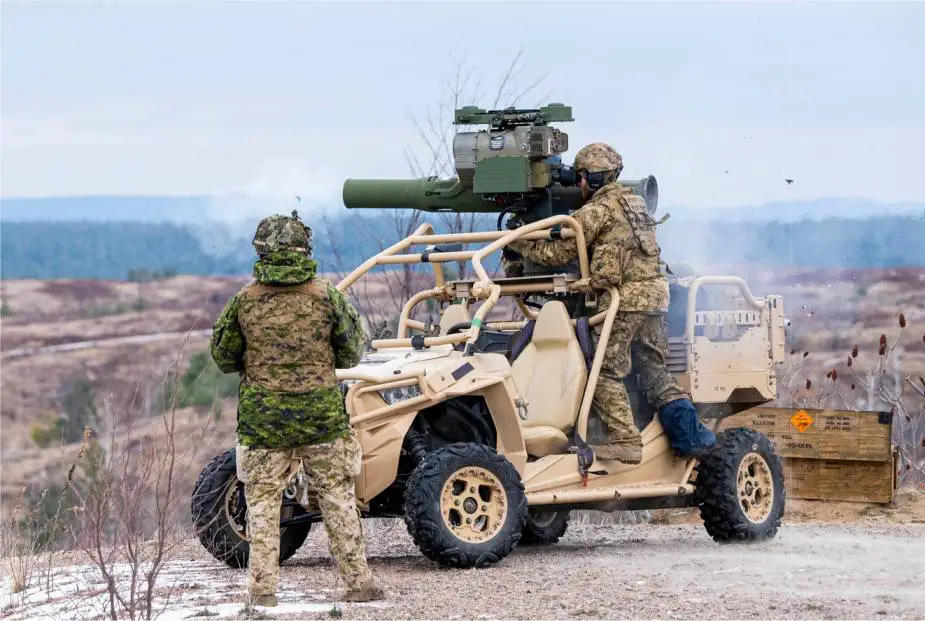On May 31, 2023, members of the 3rd Battalion, The Royal Canadian Regiment, showcased their latest efforts to increase agility and lethality on the battlefield by integrating TOW anti-tank guided missile launcher onto the MRZR Armored Vehicle during Exercise LETHAL WEAPON. This exercise, held in Petawawa, Ontario, marked a significant enhancement in the battalion's ongoing evolution, which began in November 2022.
Follow Army Recognition on Google News at this link

Canadian soldiers test Polaris MRZR equipped with TOW anti-tank guided missile launcher (Picture source Facebook 2 Canadian Mechanized Brigade Group)
During Exercise LETHAL WEAPON, 3 RCR soldiers tested a groundbreaking concept by equipping the MRZR 4x4 All-Terrain Vehicle with TOW anti-tank guided missile launcher. The modified MRZR 4X4 All-Terrain Vehicle combines the renowned agility and versatility of the MRZR platform with enhanced protection and firepower, enabling the battalion to effectively engage and neutralize armored threats on the battlefield.
The TOW (Tube-launched, Optically tracked, Wire-guided) is an anti-tank guided missile system that has been widely used by various armed forces around the world. It was first introduced in the 1970s and has undergone several upgrades and variants since then.
The missile is launched from a portable ground tripod or a vehicle-mounted launcher. The launch tube provides stabilization and protection for the missile during launch.
The TOW missile, a Tube-launched, Optically tracked, Wire-guided system, has different range capabilities depending on the variant. The TOW 2A variant offers an approximate range of 3,750 meters or 3.75 kilometers. The TOW 2B variant has a range of around 4,500 meters or 4.5 kilometers. The TOW 2B Aero variant, designed for engaging helicopters, low-flying aircraft, and armored vehicles, has an approximate range of 3,750 meters or 3.75 kilometers. The TOW 2B Aero-ER (Extended Range) version is an enhanced variant with an estimated range of about 8,750 meters or 8.75 kilometers.
Integrating an anti-tank missile launcher onto a Polaris all-terrain vehicle (ATV) offers significant advantages in terms of mobility, flexibility, and firepower. The ATV's off-road capabilities and maneuverability combined with the anti-tank missile launcher make it a highly mobile and agile platform that can swiftly respond to threats in various terrains. It provides rapid deployment options and can be easily transported to the battlefield by air, land, or dropped from aircraft if necessary. The integration enhances the ATV's versatility, allowing it to engage armored targets effectively and support combined arms operations. Additionally, the ATV's stealth and surprise capabilities, along with its existing support and logistics network, further contribute to its effectiveness as a cost-effective solution.
As reported by the Army Recognition editorial team on July 23, 2021, the MRZR vehicle, manufactured by the American company Polaris Defense, is a versatile 4x4 off-road vehicle. It can accommodate up to four people, with two seats at the front and two in the middle and a cargo area at the rear for transporting equipment and supplies. With compact dimensions of 3.55 meters in length, 1.51 meters in width, and 1.87 meters in height, the MRZR is perfectly suited for maneuvering in tight environments. With a payload capacity of 680 kg, it is capable of carrying the necessary equipment for commando missions. Equipped with an advanced suspension system, all-wheel drive, and power steering, the MRZR Armored Vehicle ensures maneuverability, enabling 3 RCR to swiftly respond to dynamic battlefield conditions.
The goal of the exercise Lethal Weapon led by the Canadian Army is to explore and test the feasibility of a new operational concept involving equipping the Polaris MRZR all-terrain vehicles with heavy armaments such as TOW anti-tank missiles, machine guns, and automatic grenade launchers.
The main objective is to enhance the anti-tank capability of the Canadian Army's light units by providing them with versatile and mobile vehicles capable of engaging more significant threats on the battlefield. By adding such weapons to the MRZRs, the units could benefit from increased firepower and enhanced flexibility to conduct offensive and defensive operations.
This program also aims to assess the stability, accuracy, and safety of the MRZRs when equipped with heavier armaments. Through testing and exercises, the goal is to determine if these vehicles can maintain their off-road mobility and agility while carrying more substantial weapons.
Drawing inspiration from experiences in conflicts like Ukraine, where armed light vehicles have been successfully employed against heavier enemy forces, the Canadian Army seeks to develop similar capabilities for its own units. The MRZR Armored Vehicle has gained recognition and is being tested by numerous armies worldwide. It has garnered attention for its adaptability and versatility, allowing for various customizations and mission-specific configurations to meet the diverse operational requirements of different armed forces.
















